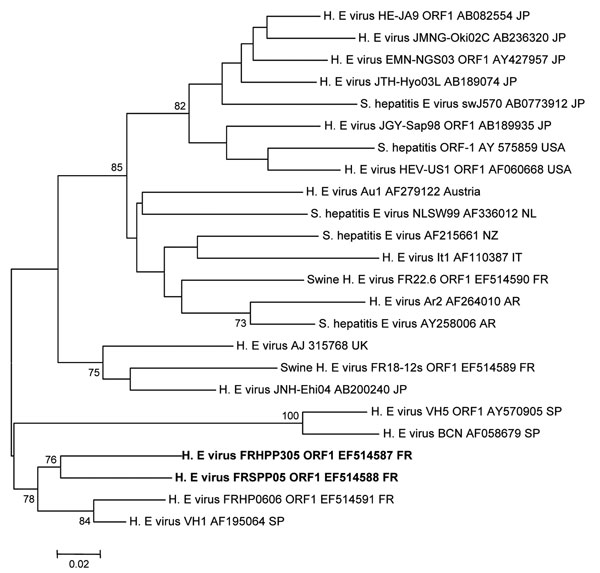Possible Zoonotic Transmission of Hepatitis E from Pet Pig to Its Owner
Christophe Renou*, Jean-Francois Cadranel†, Marc Bourlière‡, Philippe Halfon§, Denis Ouzan¶, Hervé Rifflet#, Philippe Carenco*, Abdelouahid Harafa*, Jean Jacques Bertrand*, Annie Boutrouille**, Pierre Muller*, Jean-Pierre Igual*, Anne Decoppet††, Marc Eloit**, and Nicole Pavio**

Author affiliations: *Centre Hospitalier d’Hyères, Hyères, France; †Centre Hospitalier, Creil, France; ‡Hôpital Saint-Joseph, Marseille, France; §Hôpital Ambroise Paré, Marseille, France; ¶Institut Arnaud Tzanck, Saint-Laurent du Var, France; #Centre Hospitalier, Ajaccio, Corsica, France; **Agence Française de sécurité Sanitaire des Aliments, Ecole Nationale Vétérinaire d'Alfort, Institut National de la recherche Agronomique, Maisons-Alfort, France; ††Direction Départementale des Affaires Sanitaires et Sociales du Var, Toulon, France;
Main Article
Figure 1

Figure 1. Phylogenetic tree (neighbor-joining method) of hepatitis E virus (HEV) genotype 3 isolates for a 210-nt sequence within the open reading frame (ORF) 1 gene (corresponding to nt 167–376 of the prototype swine genotype 3 pSHEV-3 AY575859). Patient (EF514587) and pet pig (EF514588) sequences are in boldface and were compared with French isolates or known isolates from regions where HEV is not endemic. GenBank accession no. and country of origin are indicated. Reliability of the different phylogenetic groupings was evaluated by using a bootstrap test (1,000 replications); scores >70% are indicated. Scale bar indicates no. of nucleotide substitutions per site. JP, Japan; USA, United States; NL, the Netherlands; NZ, New Zealand; IT, Italy; FR, France; AR, Argentina; UK, United Kingdom; SP, Spain.
Main Article
Page created: June 21, 2010
Page updated: June 21, 2010
Page reviewed: June 21, 2010
The conclusions, findings, and opinions expressed by authors contributing to this journal do not necessarily reflect the official position of the U.S. Department of Health and Human Services, the Public Health Service, the Centers for Disease Control and Prevention, or the authors' affiliated institutions. Use of trade names is for identification only and does not imply endorsement by any of the groups named above.
